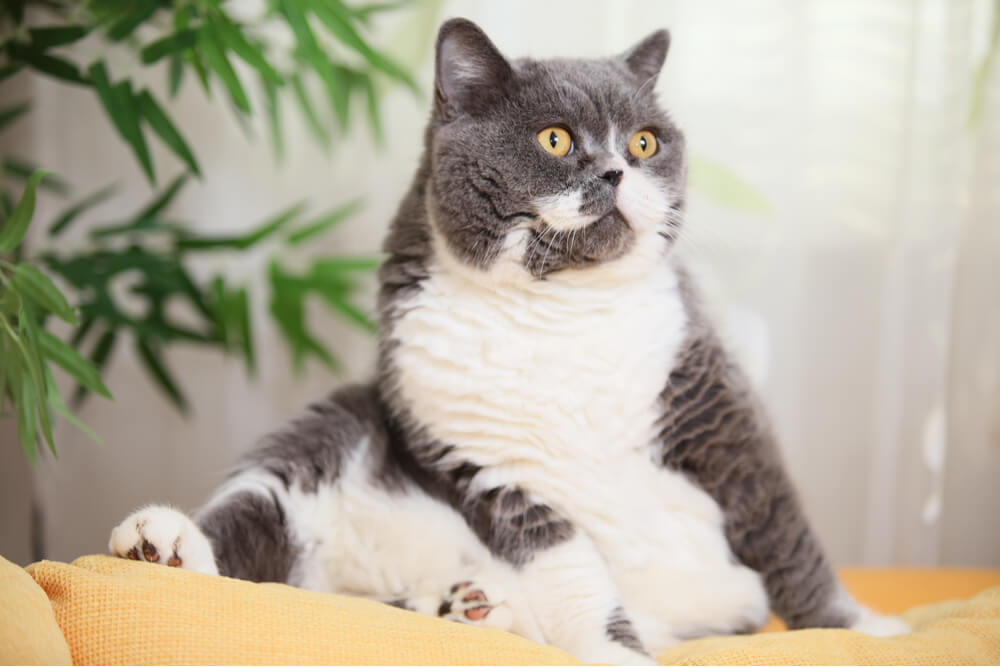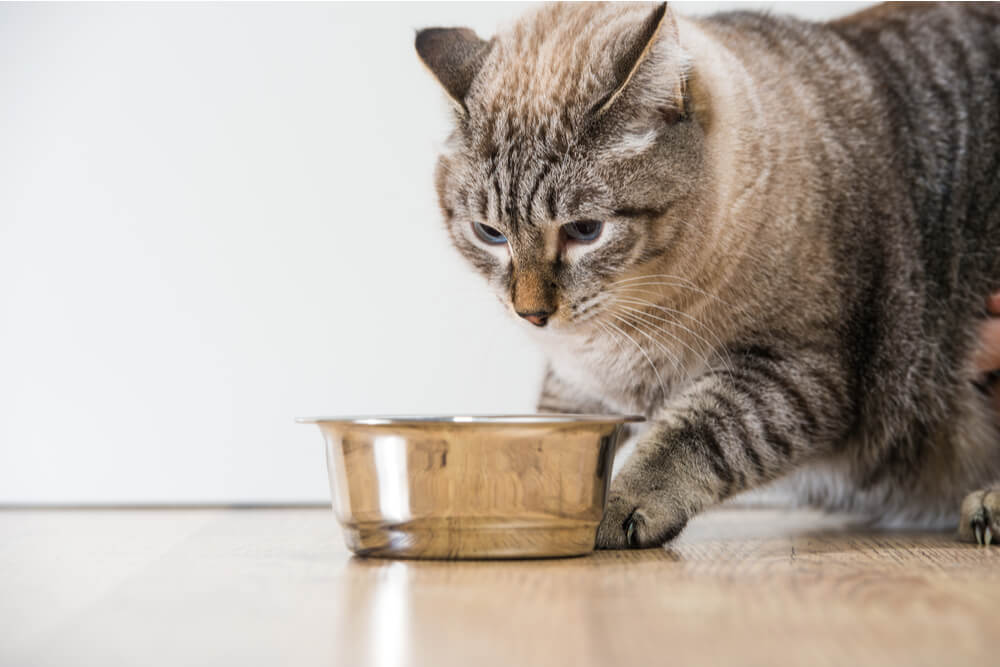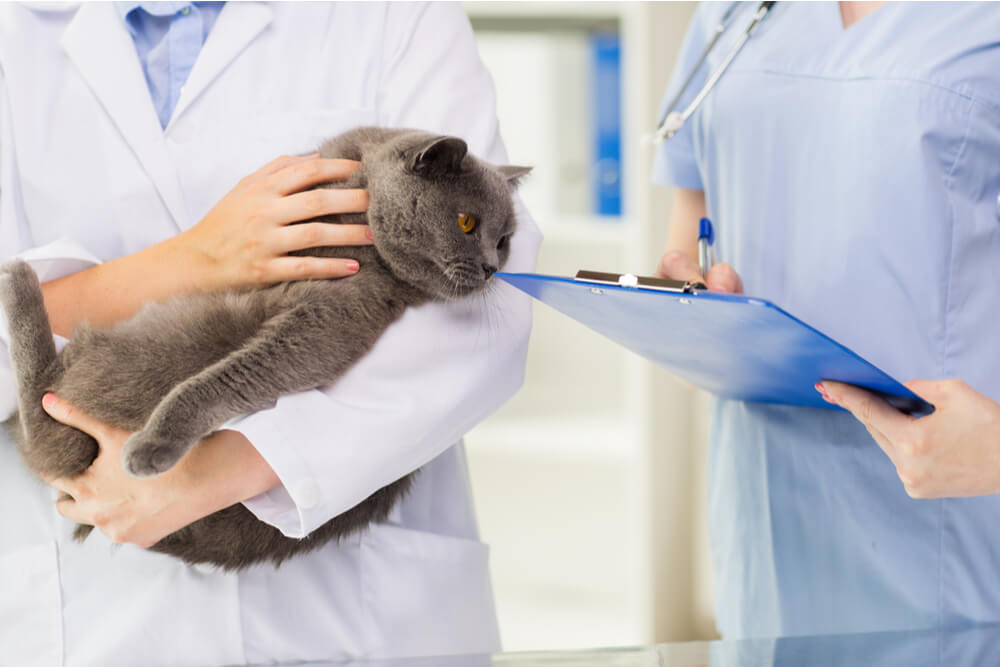
About Fatty Liver Disease in Cats
Fatty Liver Disease, also known as Feline Hepatic Lipidosis (FHL) or Fatty Liver Syndrome, is one of the most common liver diseases seen in cats.
It’s a complex type of feline liver failure that is still not fully understood. It can happen as a primary condition (i.e. as the only problem, on its own).
More commonly, it tends to be secondary to some other primary condition (e.g. diabetes mellitus, pancreatitis, inflammatory bowel disease, kidney disease, hyperthyroidism, some other type of liver disease).
The condition is typically seen in middle-aged, obese, or overweight cats that have stopped eating for a couple of days or more. Lipids (fats) accumulate inside the affected cat’s liver cells, and the consequent disease process then aggravates the original issue which caused the cat to stop eating in the first place.
Quick Overview: Fatty Liver Disease in Cats
 Other Names: Feline hepatic lipidosis (FHL), fatty liver syndrome
Other Names: Feline hepatic lipidosis (FHL), fatty liver syndrome
 Common Symptoms: Anorexia (absent appetite), weight loss, jaundice/icterus (yellowing of eyes, gums, and skin), vomiting, diarrhea, constipation, head pushed to the ground (neck ventroflexion)
Common Symptoms: Anorexia (absent appetite), weight loss, jaundice/icterus (yellowing of eyes, gums, and skin), vomiting, diarrhea, constipation, head pushed to the ground (neck ventroflexion)
 Diagnosis: History of absent appetite for at least 24-48 hours or longer, bloodwork, x-rays, ultrasound, fine needle aspirate for cytology or biopsy of liver tissue.
Diagnosis: History of absent appetite for at least 24-48 hours or longer, bloodwork, x-rays, ultrasound, fine needle aspirate for cytology or biopsy of liver tissue.
 Requires Ongoing Medication: No
Requires Ongoing Medication: No
 Vaccine Available: No
Vaccine Available: No
 Treatment Options: Focus is on getting a cat to eat again. Appetite stimulants and supportive care may help but in many cases, a feeding tube is required. Because hepatic lipidosis can have several underlying causes, the underlying cause must also be addressed for hepatic lipidosis to fully resolve.
Treatment Options: Focus is on getting a cat to eat again. Appetite stimulants and supportive care may help but in many cases, a feeding tube is required. Because hepatic lipidosis can have several underlying causes, the underlying cause must also be addressed for hepatic lipidosis to fully resolve.
 Home Remedies: Prevention by ensuring proper access to food and having a system in place to recognize if your cat has stopped eating.
Home Remedies: Prevention by ensuring proper access to food and having a system in place to recognize if your cat has stopped eating.
Causes of Fatty Liver Disease in Cats

When an overweight or obese cat doesn’t eat for an extended period of time, excess body fat spreads to the liver and causes secondary problems in the cat’s metabolism, leading to the signs of Fatty Liver Disease.
The main precipitating issue is the fact that the cat is carrying extra body weight in the first place. Then, when the cat stops eating for any reason, this extra fat in the cat’s body is mobilised, and the liver is flooded with excessive fats that accumulate inside liver cells. This then causes secondary problems in the cat’s metabolism, leading to the signs of Fatty Liver Disease.
There are many possible causes of this initial loss of appetite, ranging from a primary disease (such as those listed above) to a significant change in the cat’s lifestyle (e.g. sudden change of diet, or social change in the household such as a new pet, etc).
The problem is that the lack of food being absorbed into the bloodstream forces the body to tap into the body’s fat stores for its needs, and in a cat that is carrying too much body fat, this leads to the mass release of fats into the bloodstream at a greater level than the liver can tolerate.
Symptoms of Fatty Liver Disease in Cats
The initial problem is that the cat stops eating, for one of the reasons listed above. This may be a seemingly simple reason (e.g. diet changes) or it may be more serious (e.g. diabetes mellitus).
However, after a few days of being inappetent, the signs of Fatty Liver Disease itself begin to show.
There may be obvious, rapid weight loss with muscle wasting, the cat may become dull and unwilling to move around, and more serious signs include vomiting, diarrhea (or sometimes constipation), jaundice (yellowing of the gums), drooling (hypersalivation), and ventroflexion of the neck (pushing the head down to the ground, as if starting to do a tumbleturn).
Diagnosis of Fatty Liver Disease

If fatty liver disease is suspected, your veterinarian will perform a series of tests to determine if your cat has the condition.
This condition will be suspected by your veterinarian if the history and signs listed above are identified.
Physical Examination
On physical examination, the liver may be felt to be enlarged, and over 70% of cases exhibit jaundice (icterus, or yellow gums).
Blood Tests
Blood tests for liver function will show marked elevations of liver enzymes (such as ALT, GGT, ALKP, and AST), as well as high levels of bilirubin (hence the jaundice). Ultrasound will show a diffusely enlarged liver, and if computerised tomography (a CT scan) is carried out, the CT number of the liver will be raised.
Fine Needle Aspirate (FNA)
To confirm the diagnosis, as well as blood work, your DVM veterinarian may recommend a Fine Needle Aspirate (FNA) which uses a very small sample of liver tissue obtained by passing a very fine needle through the skin into the liver.
Characteristic changes are often seen in over 80% of the liver cells. A liver biopsy could be used to make a definitive diagnosis, but this is not generally necessary.
How Do You Treat Fatty Liver Disease in Cats?

The primary aim is to get the cat eating again: the issue is caused by metabolic changes that happen when a cat is not absorbing any food via their digestive system.
Since Fatty Liver Disease causes cats to lose their appetite, it is not always so easy to get them to take in the food that they need to get them onto the road to recovery.
Force-feeding has sometimes been carried out (restraining the cat, and either placing food into their mouths, and clamping their jaws shut, or using a syringe with liquid food). This approach is not recommended, as it causes stress and fear, and may lead cats to dislike food, even more, leading to an even longer period of inappetence.
A feeding tube (a flexible, rubbery type of tube) is needed for most cats, and this needs to be put in place under anaesthesia. Three types are available.
- A naso-esophageal tube is placed through a nostril, to the back of the nose and then into the esophagus. These tubes are narrow, so they require the use of liquid food for feeding.
- An esophagostomy tube or pharyngostomy tube is inserted through an incision in the side of the cat’s neck: these are wider bore, so allow the use of normal food that’s been liquidified to be given via a large syringe.
- A gastrotomy tube may be placed directly into the cat’s stomach through the abdominal wall: these are not used so commonly, as they tend to be more complicated.
The aim is to feed the cat a daily allowance of around 50 kcal/kg of their ideal weight, using a balanced, digestible, “recovery” type of diet.
This should be given in frequent small meals (e.g. six times daily), starting with lower quantities and gradually building up as the animal’s body readjusts to the food intake.
Other supportive treatment is usually needed, including:
- Intravenous fluid therapy (“ a drip”)
- Vitamin K and vitamin B12 supplementation
- Liver-supportive medication such as L-carnitine and S-adenosyl-L-methionine (SAMe)
- Where indicated, medication to stop vomiting
It also important, of course, to concurrently treat any primary disorder that has led to the period of inappetence which was the precursor to Fatty Liver Disease.
Blood clotting problems can develop in this disease, so veterinary care may include monitoring red blood cell parameters on blood tests.
Careful monitoring by the veterinary team is important: in particular, “refeeding syndrome” is a common complication that can develop within the first two days of food ingestion recommencing. This is a life-threatening metabolic crisis caused by disturbances to the electrolyte levels in the blood that can be prompted by the sudden ingestion of food after a period of fasting.
The gradual reintroduction of food, in small quantities only, and slowly increasing, aims to prevent the onset of this issue.
As well as treating Fatty Liver Disease specifically, it’s also important that any underlying condition, as mentioned above, is also treated effectively.
The primary aim of all cat carers should be to prevent Fatty Liver Disease by ensuring that their cats do not become overweight or obese.
And all owners of overweight or obese cats should be aware of the fact that extra body weight is a key risk factor for this condition. They should be aware of the clinical signs of this condition, and they should be ready to take urgent action if their cat stops eating for more than a day.
Frequently Asked Questions
Does my cat need to be hospitalised for treatment?
Intensive treatment is needed when this is diagnosed, with monitoring of blood samples etc, so affected cats require immediate hospitalisation. However many cats quickly learn to accept tube feeding, so once they have been stabilised, they may be able to be sent home.
How long does the feeding tube need to be left in place?
Cats need to have assisted feeding until they are eating enough on their own, so this may be anything from three to ten days or more. Each case is different, and your vet is the best person to advise you.
What is the prognosis for Fatty Liver Disease?
It’s difficult to predict the outcome for cats with this condition, as there are so many variables. Not only does Fatty Liver Disease need to be treated, but the underlying primary problem often also needs to be addressed. For this reason, survival rates vary from 20% to 80%. Again, for more detail, discuss your cat’s individual condition with your veterinarian.
How long can a cat live with Fatty Liver Disease?
Without treatment, fatty liver disease may rapidly be fatal: urgent veterinary assistance is essential. With treatment, once the cat has recovered, they will often return to normal life, without recurrence of this challenging condition.
How much does it cost to treat Fatty Liver Disease in cats?
The cost depends on the severity of the condition, any underlying primary problems, and the degree of veterinary intervention needed versus home care as the cat recovers. The total cost can therefore vary widely, e.g. from $600 to $6000.







